Webster-Ashburton Treaty Plaque, Washington D.C.
Introduction
Text-to-speech Audio
This plaque commemorating the lasting friendship between United States and Canada following the Webster-Ashburton treaty and be found on the east side of the Treasury Building. As a result of this treaty the United States and Canada were able to peacefully come to an agreement on the boarder between Maine and New Brunswick. Had this treaty not been successful, both sides had already organized small bands of soldiers and could of started a potential war between the two. Instead of marking a war, the successful peace negotiated between the two nations stands an example of lasting friendship between these newly formed North American nations.
Images
Commemorative plaque
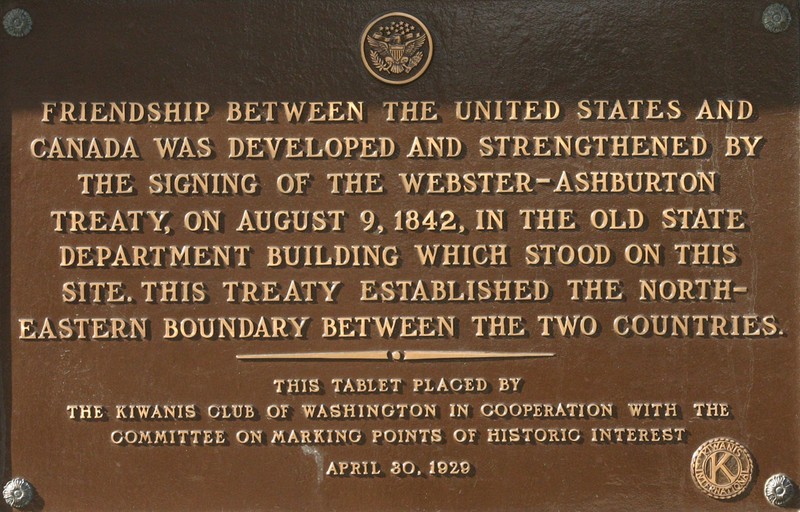
Map showing the disputed borders and the one settled in the treaty
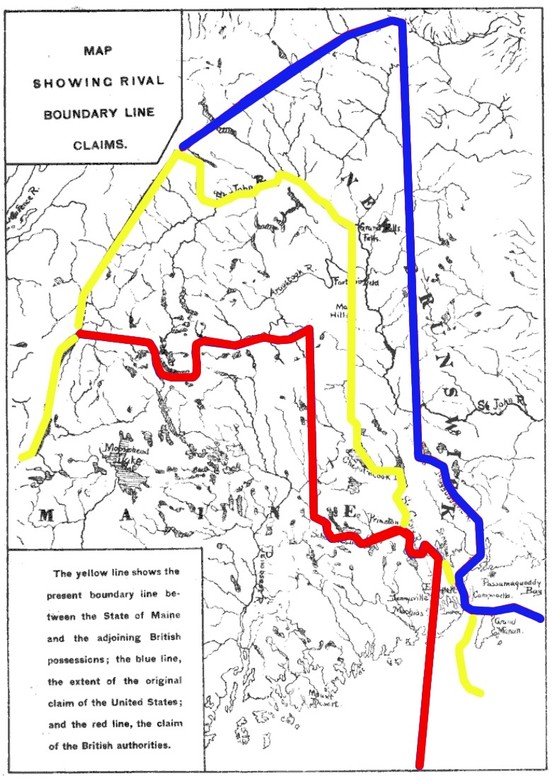
Another map of the disputed borders
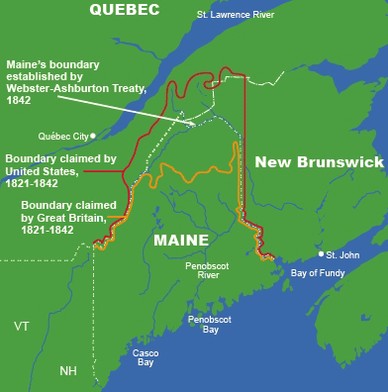
US Secretary of State Daniel Webster, circa 1841
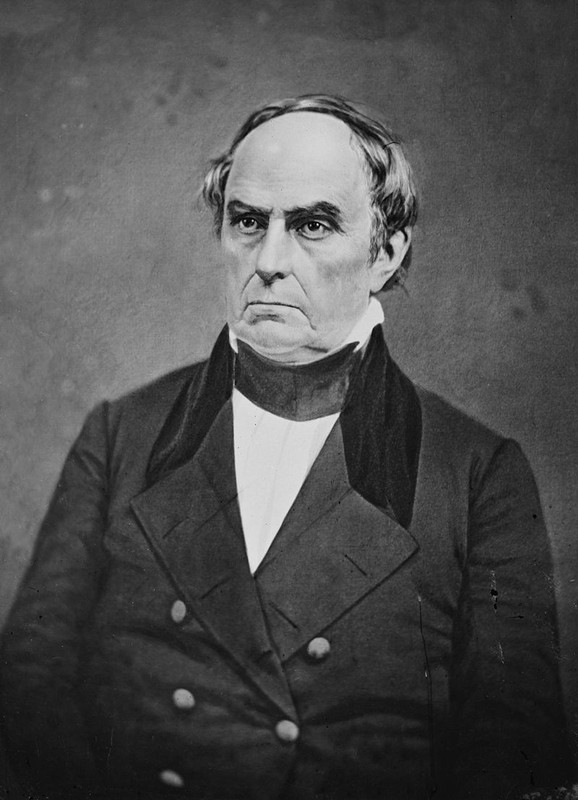
Portrait of Alexander Baring, 1st Baron of Ashburton
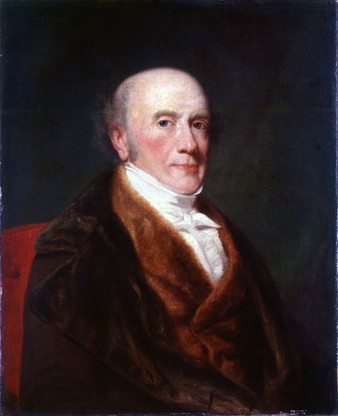
Backstory and Context
Text-to-speech Audio
The Aroostook War between Canada and the United States took place in 1838. The two countries expanding and marking their boarders came to conflict over how the land should be settled. Canada's New Brunswick and the United States Maine claimed many lands in the same area. Canada, still at this time a British colony, required that New Brunswick be maintained because of the necessity to have an easy connection to Great Britain. While Maine having control of most of the area and land wanted to control the full peninsula.
As a result of the disputes over land claims, small military forces started to be sent to the area encase of a war. Negotiations began soon after. The representative from the United States was the Secretary of State, Daniel Webster. On the British side of the negotiations was Baron Ashburton. They were able to quickly come to an agreement realizing the goals of both sides.
As a result of the disputes over land claims, small military forces started to be sent to the area encase of a war. Negotiations began soon after. The representative from the United States was the Secretary of State, Daniel Webster. On the British side of the negotiations was Baron Ashburton. They were able to quickly come to an agreement realizing the goals of both sides.
Contrary to the name, this is more of a diplomatic affair than a military affair. Militia forces for both countries were called and standing by, but no actually battles took place and no soldiers died in any confrontations. The final agreement gave most of the land to Maine, but allowed Canada to keep access to the Atlantic Ocean through the area, and allowed for a train system to be built through Maine for fast travel to the area. As a result both sides were greatly satisfied with the outcome. In 1929 the Kiwanis Club in Washington D.C. commemorated a plaque in honor of the treaty as a sign of good relations and lasting friendship between the United States and Canada.
Cite This Entry
Trowbridge, David J., Michael Sexton, and Mike Emett . "Webster-Ashburton Treaty Plaque, Washington D.C.." Clio: Your Guide to History. October 5, 2016. Accessed April 1, 2025. https://theclio.com/entry/7765
Sources
Carroll, Francis M. A Good and Wise Measure: The Search for the Canadian-American Boundary, 1783-1842. Toronto: University of Toronto Press, 2001.
Solberg, M. "WEBSTER-ASHBURTON Treaty, Plaque Commemorating on the East Side of the Treasury Dept Bldg in Washington, D.C." WEBSTER-ASHBURTON Treaty, Plaque Commemorating on the East Side of the Treasury Dept Bldg in Washington, D.C. Accessed November 1, 2014.
Carroll, Francis M. (March 1997). "The Passionate Canadians: The Historical Debate about the Eastern Canadian-American Boundary". New England Quarterly. . 70 (1): 83–101. JSTOR 366528.
——— (2001). A Good and Wise Measure: The Search for the Canadian-American Boundary, 1783–1842. University of Toronto Press. (the standard scholarly history)
——— (2003). "Drawing the Line". Beaver. 83 (4): 19–25.
Corey, Albert B. (1941). The Crisis of 1830–1842 in Canadian-American Relations.
Jones, Howard (March 1975a). "The Peculiar Institution and National Honor: The Case of the Creole Slave Revolt". Civil War History. 21 (1): 28–50. doi:10.1353/cwh.1975.0036.
——— (December 1975b). "Anglophobia and the Aroostook War". New England Quarterly. 48 (4): 519–539. JSTOR 364636.
——— (1977). To the Webster–Ashburton Treaty: A Study in Anglo-American Relations, 1783–1843.
Jones, Wilbur Devereux (February 1956). "The Influence of Slavery on the Webster–Ashburton Negotiations". Journal of Southern History. 22 (1): 48–58. JSTOR 2955259.
Kennedy, David M.; Bailey, Thomas Andrew & Cohen, Lizabeth (2006). The American Pageant (13th ed.). Boston: Houghton Mifflin. ISBN 0618479279. OCLC 846067545.
Lass, William E. (1980). Minnesota's Boundary with Canada. St. Paul, MN: Minnesota Historical Society.
LeDuc, Thomas (December 1964). "The Webster–Ashburton Treaty and the Minnesota Iron Ranges". Journal of American History. 51 (3): 476–481. JSTOR 1894897. (shows the value of the iron range was not known when the treaty was drawn)
Merk, Frederick (December 1956). "The Oregon Question in the Webster–Ashburton Negotiations". Mississippi Valley Historical Review. 43 (3): 379–404. JSTOR 1893529.
Remini, Robert (1997). Daniel Webster. pp. 535–64.
The Maine Council (1904). Historical Sketch Roster of Commissioned Officers and Enlisted Men Called Into Service for the Protection of the Northeastern Frontier of Maine from February to May 1839. Augusta, ME: Kennebec Journal Print. pp. 4–5.

